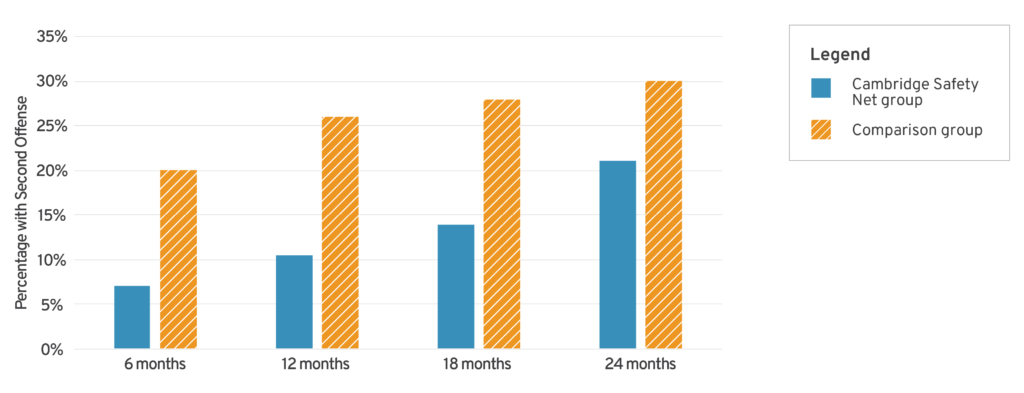Juvenile Deflection
Author
Media Contact
For general and media inquiries and to book our experts, please contact: pr@rstreet.org
Background
When a teenager is picked up for fighting or shoplifting, police face a difficult choice: Involve the justice system or let them go.
A delinquency charge can dramatically alter a young person’s future, yet a mere warning can leave underlying needs unmet. Juvenile deflection programs (aka pre-arrest diversion) redirect young people away from arrest at their first point of contact with police. Compared to punitive options like probation or detention, this approach achieves superior public safety outcomes at a lower cost to taxpayers.
Deflection vs. Diversion
Deflection and diversion are different program models with the same objective: to hold young people accountable without subjecting them to the negative consequences of an arrest. They both limit youth contact with the formal justice system, though at different points in the process. Deflection happens before an arrest, whereas diversion happens after an arrest or court referral. Diversion provides children with an off-ramp out of the system, while deflection keeps them away entirely.
Research shows that the more contact youth have with the justice system, the higher their risk of negative life outcomes (see Figure 1). Once a young person becomes entrenched in the system, they are significantly more likely to be convicted of a crime as an adult. Even a single arrest can harm the odds of rehabilitation by severing social ties and delaying educational milestones. One longitudinal study of 7,304 children over 35 years concluded that “rather than providing a public safety benefit, processing a juvenile through the system appears to have a negative or backfire effect.”
Figure 1: Consequences of Arrest
Deflection Benefits
Deflection gives young people a chance to learn from their mistakes and get help before facing the full brunt of the justice system. Options range from releasing them with a warning to mandating substance abuse treatment. It is a particularly good alternative for so-called “status offenses” that apply only to children, such as underage drinking or truancy. Like fixing a pipe before it bursts and floods the whole house, deflection addresses delinquent behavior before it escalates.
Early interventions like deflection are particularly suited to juvenile justice because children’s brains have higher neuroplasticity than adult brains. The prefrontal cortex—the part responsible for decisions and impulse control—develops rapidly during adolescence. While this makes teens more susceptible to negative influences, it also makes rehabilitation more effective.
Not only are youth deflected before arrest substantially less likely to reoffend within 12 months than those diverted after arrest, they are also half as likely to be arrested as adults. By reducing recidivism and saving taxpayer money, deflection provides a superior return on investment compared to diversion.
Civil Citation
Florida law requires local courts to offer a “civil citation” to first-time offenders who commit certain nonviolent misdemeanors. The citations are akin to traffic tickets in that, if a child completes the required community service or restitution, their case is closed and they avoid a delinquency record. For example, a teen caught tagging an underpass with gang graffiti might be referred to a community-based art program. If the child fails to complete the terms of the citation or commits a new offense, they can be arrested and prosecuted—a punitive backstop that incentivizes accountability. Civil citation is responsible for a stark decrease in the number of Florida youths arrested, put on probation, and placed in residential commitment. Additionally:
- Youth who complete the civil citation program are 50 percent less likely to be rearrested at six months (and 30 percent less likely at three years) compared to those formally arrested.
- Only 4 percent of Florida youth who receive civil citations reoffend within 12 months, compared to 13 percent who go through probation.
- Florida’s Fourth Judicial Circuit uses civil citations in 90 percent of eligible cases, preventing over 1,000 juvenile arrests per year and saving taxpayers nearly $5 million annually.
Police-led Deflection
A successful deflection program must begin with the first point of contact: law enforcement. For some young people, police contact is their first-ever opportunity to access mental health support. But police-led deflection does not necessarily mean police-only deflection. In fact, research shows that deflection is most effective when integrated with existing community-based services.
The Safety Net Collaborative in Cambridge, Massachusetts, is a multi-agency deflection initiative that blends funding streams, case planning, and expertise across the law enforcement, education, and behavioral health systems. Youth resource officers (YROs) meet with healthcare providers and school officials regularly to develop plans tailored to each child. Unlike traditional school resource officers, who are confined to campus, YROs build meaningful relationships with youth and families in the community, reframing the role of police from antagonist to advocate.
Safety Net’s data-driven, multi-disciplinary approach is among the most thoroughly evaluated of any U.S. deflection program:
- Since its inception, juvenile arrests have declined at a statistically significant rate compared to local and national averages.
- Youth deflected through Safety Net have lower recidivism rates compared to those in the regular juvenile system.
- Safety Net youth receive necessary mental health or substance abuse treatment more often and more promptly than they would have otherwise.
Figure 2: Percentage of Youth with Second Offense

Conclusion
Juvenile deflection is a scalable, bipartisan strategy that aligns fiscal responsibility with evidence-based public safety. Multidisciplinary, police-led response programs like Florida’s civil citation system and the Cambridge Safety Net Collaborative preserve law enforcement discretion while embedding accountability within a developmentally appropriate continuum of care. While these models are structured differently, they share the same philosophy: The best way to improve public safety—and save taxpayer money—is to keep children out of the justice system in the first place.
R Street Disclaimer: This research was funded in part by The Annie E. Casey Foundation and the R Street Institute. We thank them for their support; however the findings and conclusions presented in this report are those of the authors alone and do not necessarily reflect the opinions of these organizations.
